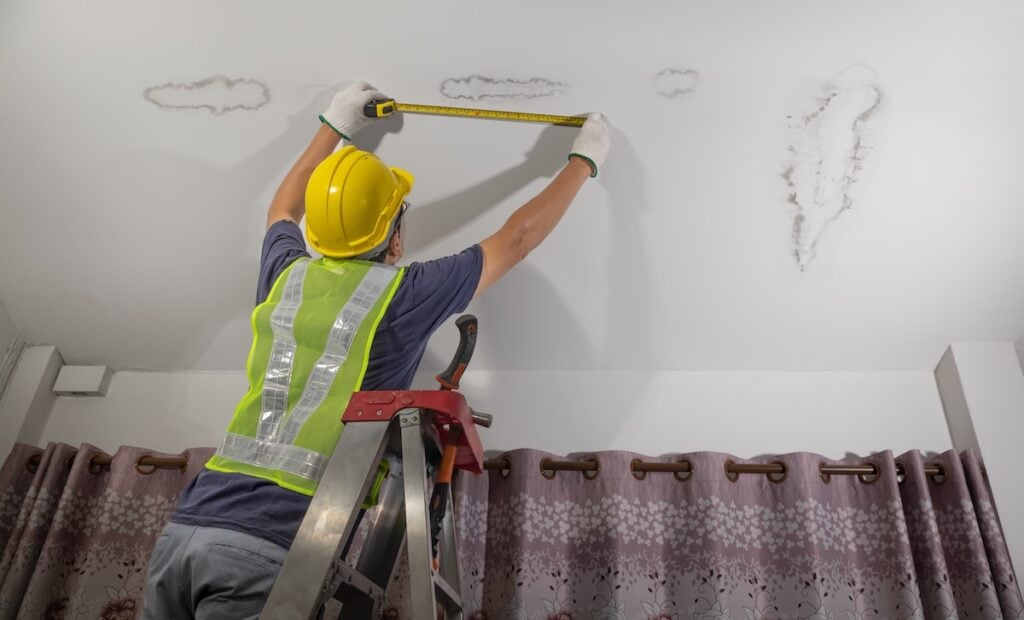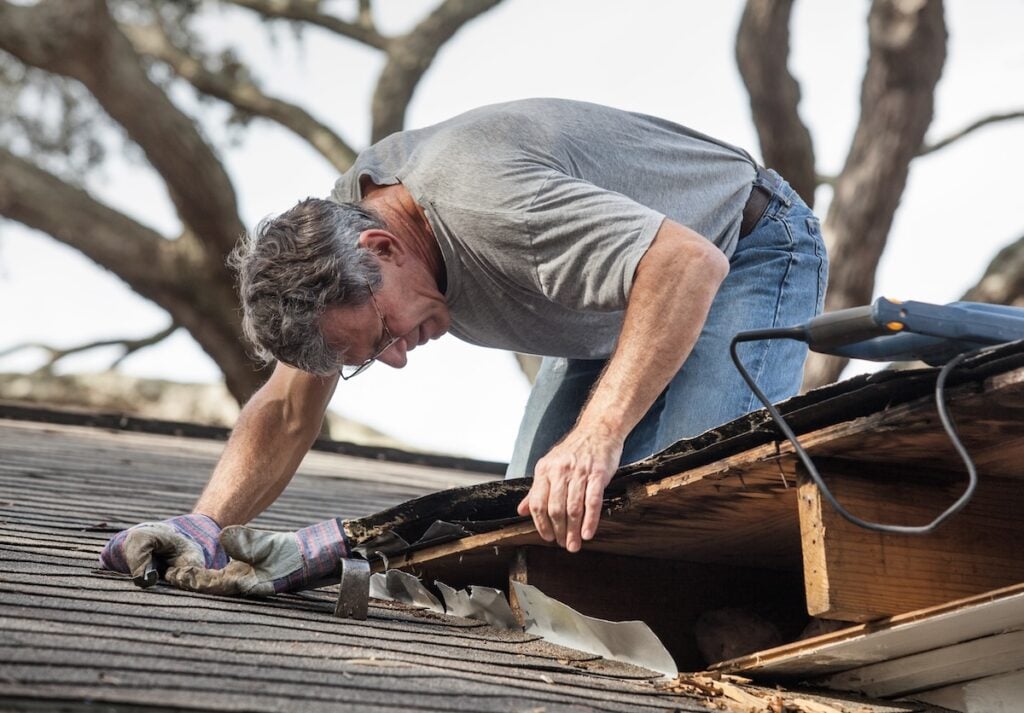
How To Find A Roof Leak: 7 Quick Detection Tips
July 30,2025
6 minutes Read
Knowing how to find a roof leak quickly can prevent small issues from turning into major damage. Leaks are sneaky—they often start silently and only become visible after they’ve already compromised insulation, drywall, or even structural framing. The sooner you locate the source, the better chance you have of avoiding a costly repair.
- Mold, water stains, or peeling paint may signal a hidden leak
- Attic inspections can help pinpoint the origin of the problem
- Fast action can save you thousands in long-term damage
Below, we’ll walk you through how to spot a leak early and what to do once you’ve found it.
💧 Why Quick Leak Detection Matters
Roof leaks don’t stay small for long. Water can travel far from the entry point before signs appear, which means that what looks like a minor drip could indicate major hidden damage. Learning how to detect leaks early helps protect your home’s roof, insulation, drywall, and even electrical systems.
Plus, acting quickly gives you the option to repair instead of replace. Small leaks can often be fixed without a full roofing overhaul—if you catch them soon enough.

⚠️ Common Warning Signs of a Roof Leak
Before you climb into the attic or call a contractor, it helps to know what warning signs to look for around your home.
- Water Stains on Ceilings or Walls: One of the most noticeable signs is a brownish or yellowish water ring on your ceiling or walls. These stains may appear dry but are often a result of ongoing water intrusion from above.
- Mold or Mildew Growth: Moisture that enters your attic or walls can lead to the growth of mold and mildew. If you notice a musty odor or visible spots in the upper corners of rooms, it could indicate a hidden leak.
- Dripping or Peeling Paint: When water seeps in behind your walls or ceiling, it causes paint to blister, peel, or bubble. You might also see sagging drywall in some cases.
🔍 Best Areas To Check for a Leak
Sometimes leaks are easy to spot. Other times, they require a bit of detective work. Here’s where to look first.
In the Attic
Head to your attic with a flashlight during or after rainfall. Look for wet rafters, dark water stains on the wood, or obvious dripping. Pay attention to any nails or fasteners with rust spots—that’s a sign of moisture.
Around Roof Penetrations
Leaks often form around features that disrupt the roofline like vents, skylights, chimneys, or satellite mounts. Check flashing, caulking, and seals in these areas carefully.
Along Roof Valleys and Edges
Valleys—where two roof slopes meet—are prime leak locations due to the volume of water that runs through them. Ice dams along eaves or poor shingle overlap can also lead to water intrusion.
⭐️ 7 Quick Tips to Find a Roof Leak Fast
You don’t need to be a professional roofer to do some basic detective work. Here are seven homeowner-friendly ways to track down a leak.

- Trace the Stain to Its Highest Point: Start with the stain or wet spot and trace it upward—water flows downhill, so the leak source is usually above where the damage appears.
- Check the Attic During Rainfall: If it’s safe, grab a flashlight and head into the attic while it’s raining. You may spot active drips, wet insulation, or water trails.
- Inspect Flashing and Seals: Damaged flashing around chimneys, vents, or skylights is a top cause of leaks. Look for gaps, corrosion, or lifted edges.
- Look for Missing or Damaged Shingles: Use binoculars from the ground or a ladder (safely) to scan for curled, cracked, or missing shingles, especially after storms.
- Run a Controlled Water Test: Have someone spray your roof with a hose in sections while you watch from inside the attic. Once water shows up, you’ve found the general area.
- Use a Moisture Meter: These handheld devices can help detect hidden moisture behind drywall or under roofing material without visible signs.
- Follow the Rust and Rot: Corroded nails, discolored wood, or soft spots in your attic sheathing often point directly to the leak path.
📋 What to Do After Finding the Leak
Once you’ve located the leak—or narrowed it down—it’s important to act quickly. Even small drips can snowball into expensive structural repairs.
- Temporary Patching: If a roofer can’t come immediately, consider patching the leak yourself with roofing tape, sealant, or a tarp. This won’t be a permanent fix, but it can help prevent further damage during storms.
- Document for Insurance: Take clear photos of any damage, both inside and out. This documentation will be useful if you decide to file a claim with your homeowner’s insurance.
- Contact a Roofing Professional: DIY methods can only go so far. A certified roofing contractor can inspect the roof thoroughly, provide options, and make permanent repairs with the right materials.
✅ Preventing Roof Leaks Before They Start
Prevention is always better than cleanup. A well-maintained roof is less likely to surprise you with an emergency.

- Annual Roof Inspections: Scheduling a yearly inspection helps you catch wear and tear early. Professional roofers can spot flashing issues, cracked shingles, or early signs of water intrusion.
- Clean Gutters and Downspouts: Clogged gutters can lead to water pooling on your roof and eventually cause leaks. Make a habit of cleaning them out each spring and fall.
- Trim Overhanging Branches: Tree limbs that brush your roof can strip away shingles or cause debris buildup. Keep branches trimmed back to reduce risk.
- Ventilation and Insulation Checks: Improper attic ventilation can cause condensation and moisture buildup, especially in colder climates. Good airflow helps protect both your roof and your home’s energy efficiency.
📞 When To Call In the Pros
Sometimes, finding a leak is easy. Other times, the source stays hidden despite your best efforts. That’s when it’s time to bring in expert help.
- Persistent staining with no visible water source could mean the leak is traveling a long path internally.
- Multiple leak points often signal underlying issues like aging roofing materials or widespread flashing failure.
- Sagging ceilings or soaked insulation may indicate long-term water damage that needs professional remediation.
🤝 Trust Heartland for Leak Detection and Roof Repairs
Knowing how to find a roof leak can save your home from costly water damage, but locating the exact source isn’t always simple. At Heartland, our team is trained to identify and fix leaks fast—so you don’t have to play guessing games while your ceiling gets soggy.
We believe in fast service, transparent advice, and long-term solutions. If you suspect a leak, don’t wait. Contact Heartland today for a free roof inspection and expert repair recommendations. We’ll help keep your home dry, safe, and protected for years to come.

Get Started Today!
From roofing to siding, Heartland Roofing is the team you need to take your home exterior to the next level. All you need to do is reach out! Fill out our contact form or give us a call to get the reliable help that you need.
4.7 rating
94% recommend
A+ rating